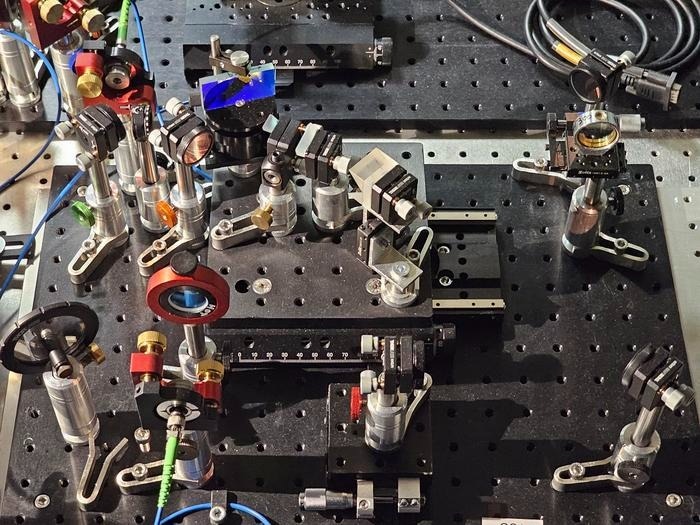Reviewed by Lexie CornerSep 13 2024
Two University of Warsaw researchers created a quantum-inspired super-resolving spectrometer for brief light pulses, according to a study published in Optica.
 Frequency lens using multiple diffraction on a diffraction grating. The light pulse is transformed in a frequency analogous to the light beam passing through the real lens (fot. M. Lipka, Uniwersytet Warszawski) Image Credit: Michał Lipka, University of Warsaw
Frequency lens using multiple diffraction on a diffraction grating. The light pulse is transformed in a frequency analogous to the light beam passing through the real lens (fot. M. Lipka, Uniwersytet Warszawski) Image Credit: Michał Lipka, University of Warsaw
Compared to conventional methods, the gadget created in the Quantum Optical Devices Lab at the Centre for Quantum Optical Technologies, Centre of New Technologies, and Faculty of Physics UW offers a resolution enhancement of more than two times.
It can be reduced in size to fit on a photonic chip and used in spectroscopic investigations of materials, quantum and optical networks, and more in the future.
Colors Bring Information
Spectroscopy is the study of light's numerous colors, or spectrum. A chemical substance emits distinctive colors that allow it to be recognized. Similarly, a distant star will have a unique light spectrum that allows scientists to determine its astrophysical parameters, such as size and age.
Different hues of light are used to transfer information over channels in fiber networks, much as different radio bands are used to transmit many channels at once. These optical channels serve as the foundation for intercontinental optical networks and will be required for future secure quantum networks.
In all of these circumstances, it is impossible to discern between nearby channels or spectroscopic lines. It was anticipated that if channels overlapped, they would be practically hard to discern - a phenomenon researched by John William Strutt, Lord Rayleigh, and later known as the Rayleigh criterion.
Quantum to the Rescue
Progress in quantum information science has led us to realize that typical direct imaging or spectroscopy discards some of the information conveyed in the phase of the complicated electromagnetic field of light. Quantum-inspired super-resolution methods modify the complicated electromagnetic field before detection, allowing this latent information to be used best.
The super-resolution of ultrafast pulses by spectral inversion (SUSI) gadget operates on a mechanism that strongly resembles the so-called quantum-inspired super-resolution techniques used in imaging. The hardest part was figuring out how to apply these concepts to time and frequency.
Just Do a Flip
For super-resolved quantum imaging, the light from the object is divided into two arms of an interferometer. One arm carries a device that flips or inverts the image. Next, the inverted part interferes with the original section. The inverted image of a single small emitter, for example, will match the original exactly if it is perfectly aligned with the inversion axis.
In this scenario, one of the interferometer's ports would be empty of photons. Nevertheless, photons will emerge in that port, and the emitter's inverted image will change from the original as soon as it is moved.
Their value provides an excellent indication of the extent of the emitter's displacement. Expanding upon this instance, one can imagine a pair of emitters that are equally spaced apart along the inversion axis.
Since each emitter will contribute identically to the counted photons, we have estimated the distance between each emitter. This precision can be far higher than imaging the emitters with a camera, even if it still has limitations like any other measurement.
Manipulating the Time and Color
In terms of time and frequency, these notions remain valid. Instead of thinking about small emitters, consider light pulses. The pulses emerge at the same moment but have somewhat varied colors because they originate from various optical channels or spectroscopic lines.
Instead of gazing directly into a camera, a common solution would include using a dispersive device such as a diffraction grating or a prism to convey various frequencies to different spots on the camera sensor. With two closely spaced pulses, these frequency distributions will generally overlap, reducing the precision with which the separation can be determined. With SUSI, one can enhance accuracy.
But how can frequency inversion be implemented? Solving this challenge was an important step in constructing SUSI. A significant insight was that, instead of using an inverter in a single interferometer arm, we might achieve the same effect by using a Fourier Transform in one arm and an inverse Fourier Transform in the other.
Dr. Michał Parniak, team leader at the Quantum Optical Devices Lab and assistant professor at the Optics Division, Faculty of Physics UW, supervised PhD student Michał Lipka's construction of a balanced and scalable device. The losses in both arms of the interferometer are equivalent, and the inverse and direct Fourier transform devices are extremely similar.
Furthermore, all elements employed in the SUSI interferometer can currently be implemented on a photonic chip, making SUSI highly practical and integrable in super-spectrometers or optical network devices, offering at least a two-fold boost in resolution over present devices. The research, which was financed by the National Science Centre through a PRELUDIUM grant, has fascinating applications.
Journal Reference:
Lipka, M., et al. (2024) Super-resolution of ultrafast pulses via spectral inversion. Optica. doi.org/10.1364/optica.522555.